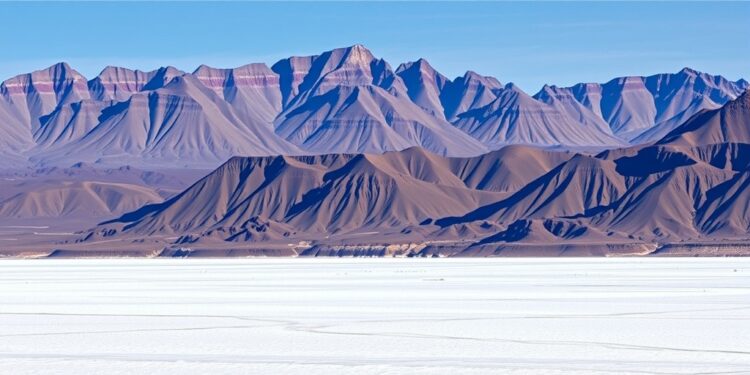According to Siiri Bigalke, the lead author of the study and a Ph.D. candidate in Portland State University’s Earth, Environment, and Society program, the Great Salt Lake plays a pivotal role in the local and regional economy. Bigalke emphasizes that the lake generates over $1.9 billion annually, a factor that underscores its importance. It serves not only as a crucial feeding ground for millions of migratory birds but also as a significant contributor to the snowpack in the Wasatch Mountain Range, home to multiple world-class ski resorts. This relationship between the lake and the local climate is especially pertinent as Salt Lake City prepares to host the Winter Olympics in 2034.
The research team, which includes co-authors Paul Loikith, an associate professor of geography and head of PSU’s Climate Science Lab, and Nick Siler, an associate professor at Oregon State University, employed a detailed computational model to simulate changes in the lake’s volume over time. Their model focused on key elements that contribute to water levels in the lake, notably the inputs from streamflow and precipitation, as well as the outputs from evaporation. By creating alternate scenarios that examined the impact of variations in these variables, the researchers successfully isolated how each factor contributed to the drastic decline observed in 2022.
The previous consensus attributed the significant drop in lake levels mainly to decreased streamflows from the lake’s three primary tributaries. Several factors were suspected to be at play, including prolonged drought conditions, water diversions for agricultural and urban use, and the overarching influence of climate change. However, the new study reveals an unexpected insight—while reduced streamflow indeed plays a dominant role, it only accounts for about two-thirds of the total decline in lake volume. The remaining third can be traced back to an increase in evaporation driven by higher temperatures, a consequence of the ongoing climate crisis, illustrating the complex interplay of various factors affecting the lake’s health.
Loikith adds an important perspective, stating that the upward trend in temperatures leads to higher rates of evaporation from the lake. This means that even if streamflows were to increase, the persistent warming effect would continue to exacerbate evaporation rates, complicating any potential for recovery in lake levels. As they stress, without the warming trend, the record low lake volume witnessed in 2022 would likely not have occurred. This critical recognition serves as a warning that efforts to address the decline need to account for both streamflow management and climate resilience strategies.
The implications of the study’s findings extend beyond ecological and economic concerns. The dwindling water levels of the Great Salt Lake also pose health risks to the local populations. As the lake shrinks, the exposed lakebed can potentially contribute to the creation of toxic dust that may be blown into the densely populated Salt Lake City metropolitan area. Bigalke points out that this dust could worsen air quality, impacting the health of over 1.2 million residents who depend on clean air for their well-being.
The research also identifies a pathway for potential short-term remediation. The study suggests that increasing streamflow has the ability to boost lake volume in the near term, providing a glimmer of hope for recovery. However, the scientists caution that under continued warming scenarios, higher evaporation rates will likely counteract these gains, leading to greater long-term water loss. The paradox underscores the pressing need for informed policy decisions targeting both immediate and sustained responses to the crisis.
Ultimately, the researchers advocate for further studies to unravel the complex dynamics at play, notably concerning local evaporation rates, precipitation patterns, and human interventions that affect streamflow. Such investigations are instrumental for developing adaptive strategies that can effectively mitigate further deterioration of the lake and its associated ecosystems.
These findings are documented in a paper published in the journal “Geophysical Research Letters.” The urgency of the situation demands attention as stakeholders consider the ramifications of the Great Salt Lake’s declining water levels. It is imperative for researchers, policymakers, and the community to work collaboratively to address the multi-faceted challenges posed by this environmental crisis, ensuring that the lake’s ecological and economic contributions are preserved for future generations.
Strengthened by the findings of this landmark study, it becomes clear that the fight for the future of the Great Salt Lake is not just about water levels—it’s a comprehensive endeavor that encompasses ecological integrity, community health, and economic sustainability. As the climatic battleground intensifies, the Great Salt Lake serves as both a warning and a call to action for the broader environmental challenges facing our planet.
Subject of Research: The factors contributing to the record low water volume in the Great Salt Lake in 2022.
Article Title: Explaining the 2022 Record Low Great Salt Lake Volume
News Publication Date: 21-Jan-2025
Web References: Geophysical Research Letters DOI
References: None
Image Credits: None
Keywords: Great Salt Lake, water decline, evaporation, climate change, ecological health, economic impact, public health, migratory birds, dust pollution, streamflow, Portland State University, environmental policy.
Tags: Climate Change ImpactDust pollutionEcological crisisEconomic consequencesEnvironmental PolicyEvaporation ratesGreat Salt Lake shrinkageMigratory bird habitatsPortland State University researchPublic Health RisksStreamflow reductionWater decline





